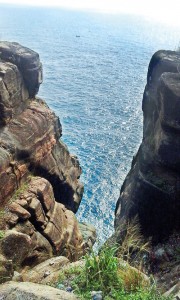Koneshwaran: Picturesque temple that has withstood currents of history

Magnificent facade of the famous temple
Many people describe Trincomalee as the Jewel of the East. The many faceted town is now the preferred destination for locals who choose to take a break.
Trincomalee is known to the modern world as one of the finest natural harbours in the world, but the origin of its name and fame from pre-historic times is said to be linked to an ancient shrine dedicated by the early Tamils to Lord Shiva.
It’s little wonder that the historic Koneshwaran Temple has the reputation of being the best-known tourist attraction where people from all walks of life throng, when they visit the city.
It was known as “The great Pagoda’ or ‘The Pagoda with a thousand Pillars’ by the Portuguese and simply “The Swami Rock’ during the British regime. Its history goes as far back as the 4th century AD.
Geologists refer to oceanic upheavals or geophysical convulsions, which are believed to have occurred more than once, possibly three times. As a result a three-cornered hillock (Thiru-Kona-Malai) was flung up by the turbulence and got lodged along the north-eastern coast.
According to puranas, Lord Shiva, accompanied by the Devas, Rishees and others, is said to have taken their abode here on Thirikonamalai and restored calm weather. And thus Thirikonamalai became a holy place, and as Shiva or Eshwaran took his abode here, it was therefore known as Thiru-Kon-Eshwaran.
Another piece of history is that Chola Kankan, a prince had arrived here on pilgrimage, in keeping with a parental vow and found the temple in shambles. He had immediately taken steps to rebuild the temple in the magnificent Pallawa architecture style.

Ravanan Veddu (sliced/cut by Ravana) with folk lore stating that Ravana cut the rocks with his sword
The name and fame of Koneshwaran spread far and wide. But around 1624, the temple was sacked and looted and later extensively damaged by the Portuguese. The temple was said to have been blasted and artifacts from this were recovered from the seas as recently as 1990.
Later, the Portuguese erected a triangular fortress, which was named Pagoda hill.
The fortress lasted only a couple of years. The British captured the fort, from the Portuguese and Hindus were allowed restricted worship with the permission of the British Military.
King George III gave the fort, the new designation of Fort Frederick, by which name it is known even today. In 1950, several ‘vigrahams’ were unearthed while excavating a trench. These were taken in procession around the country and finally installed in Koneshwaran.
The skill and precision of the workmanship are wonderful and indeed worth seeing. As you enter the temple an inexplicable but unmistakably spiritual serenity and tranquility envelops you. You feel not only the love of Siva but also the historic currents that the temple has withstood.


